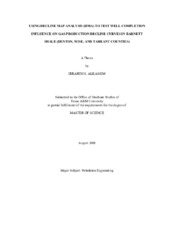| dc.description.abstract | The increasing interest and focus on unconventional reservoirs is a result of the
industry's direction toward exploring alternative energy sources. It is due to the fact that
conventional reservoirs are being depleted at a fast pace. Shale gas reservoirs are a very
favorable type of energy sources due to their low cost and long-lasting gas supply. In
general, according to Ausubel (1996), natural gas serves as a transition stage to move
from the current oil-based energy sources to future more stable and environment-friendly
ones.
By looking through production history in the U.S Historical Production Database,
HPDI (2009), we learn that the Barnett Shale reservoir in Newark East Field has been
producing since the early 90's and contributing a fraction of the U.S daily gas production.
Zhao et al. (2007) estimated the Barnett Shale to be producing 1.97 Bcf/day of gas in
2007. It is considered the most productive unconventional gas shale reservoir in Texas.
By 2004 and in terms of annual gas production volume, Pollastro (2007) considered the
Barnett Shale as the second largest unconventional gas reservoir in the United States. Many studies have been conducted to understand better the production controls in
Barnett Shale. However, this giant shale gas reservoir is still ambiguous. Some parts of
this puzzle are still missing. It is not fully clear what makes the Barnett well produce high
or low amounts of gas. Barnett operating companies are still trying to answer these
questions. This study adds to the Barnett chain of studies. It tests the effects of the
following on Barnett gas production in the core area (Denton, Wise, and Tarrant
counties):
* Barnett gross thickness, including the Forestburg formation that divides
Barnett Shale.
* Perforation footage.
* Perforated zones of Barnett Shale.
Instead of testing these parameters on each well production decline curve individually,
this study uses a new technique to simplify this process. Decline Map Analysis (DMA) is
introduced to measure the effects of these parameters on all production decline curves at
the same time.
Through this study, Barnett gross thickness and perforation footage are found not
to have any definite effects on Barnett gas production. However, zone 3 (Top of Lower
Barnett) and zone 1 (Bottom of Lower Barnett) are found to contribute to cumulative
production. Zone 2 (Middle of Lower Barnett) and zone 4 (Upper Barnett), on the other
hand, did not show any correlation or influence on production through their thicknesses. | en |


